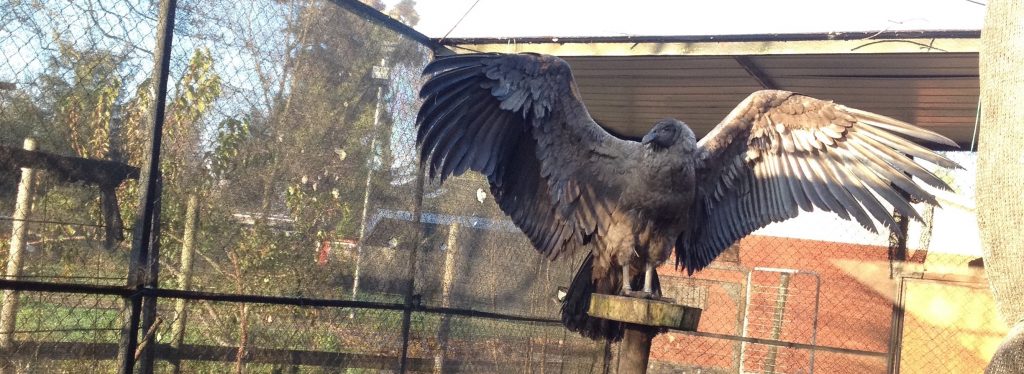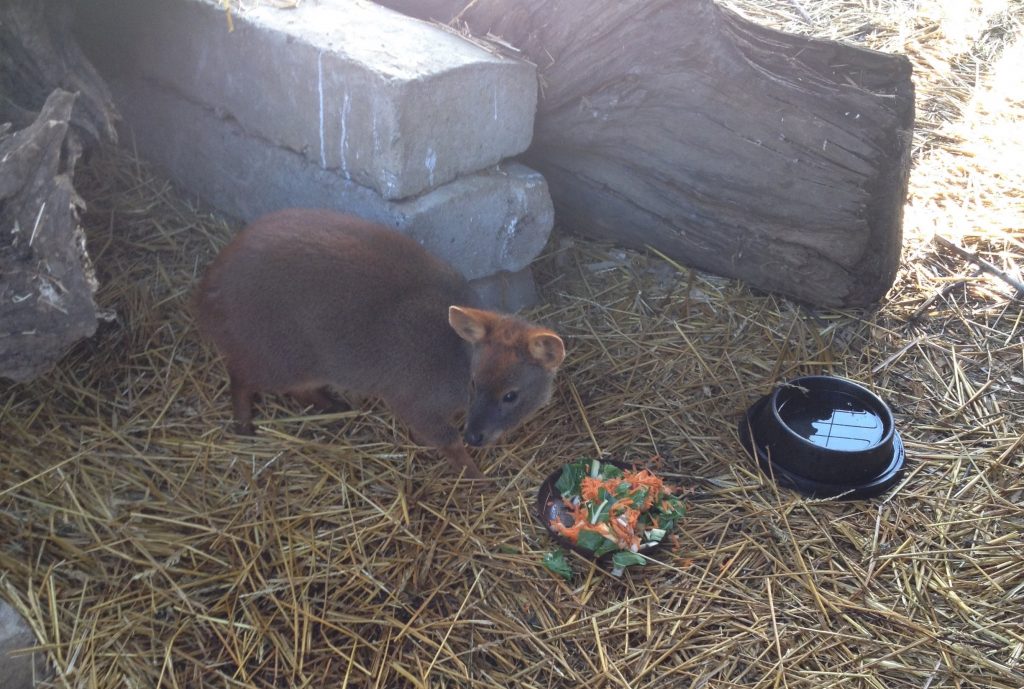
The Andean Condor (Vultur gryphus), is one of the largest flying birds in the world, with a wingspan of around 10 feet. This species is the national bird of Chile and has a near threatened conservation status since its population numbers have been in decline due to habitat loss, consuming contaminated carcasses, and hunting.
My name is Lauren Johnson, and I am a member of the Cornell University College of Veterinary Medicine class of 2020. This past summer, with support from Cornell’s Expanding Horizons program, I spent 10 weeks at the University of Concepción in Chillán, Chile. Chillán is a small city, 4 hours south of Santiago, with a traditional open-air market downtown and a picturesque countryside framed by views of mountain ranges and volcanoes. There, I worked with Chilean veterinarians to research milk quality at dairy farms in the region. While my main goal in Chile was to work with cows, I was excited to learn that the university had a wildlife clinic, since during the academic year at Cornell I work as a student technician at the Janet L. Swanson Wildlife Health Center.
The University of Concepción’s Center for the Rescue and Rehabilitation of Wildlife provides medical care and rehabilitation for native Chilean wildlife, with the end goal of releasing the animals back into the wild. The center is small, but has an indoor room with a few cages for patients and six large outdoor cages that allow birds of prey to fly and provide enough space for large mammals like foxes. Most animals are brought to the center by the Chilean government’s Agricultural and Livestock Service (which is also in charge of wildlife and conservation). The most common presenting complaint in patients is fractures due to vehicular trauma.
The center is mainly staffed by student volunteers. Each day, a team of a few students signs up to take care of the animals by preparing food, cleaning cages, and administering medications. Thanks to the coordinators of the center, I was able to join the Chilean vet students in taking care of the patients. This gave me a wonderful opportunity to meet some of Chile’s wildlife up-close. I cut up chicken necks for a Magellanic Horned Owl (Bubo magellanicus), a close relative of the Great-Horned Owl we often see at the Cornell wildlife clinic. I dug worms out of the ground for a Southern Lapwing (Vanellus chilensis), a shorebird that is commonly found on fields throughout the countryside and has a bright red spur on each wing used for fighting. I gave medication to an Austral Pygmy Owl (Glaucidium nana) about the size of my hand. I checked on the Andean Condor (Vultur gryphus), which is one of the largest flying birds in the world with a wingspan of around 10 feet. This species is the national bird of Chile and has a near threatened conservation status since its population numbers have been in decline due to habitat loss, consuming contaminated carcasses, and hunting. One of the most interesting patients was a young puma (Felis concolor) that had been hit by a car. Veterinarians performed surgery on the puma prior to my arrival in Chile, but I was able to assist in anesthesia monitoring for the re-check exam and radiographs to assess healing. After I left, the puma was moved to another rehabilitation center by Chile’s Agricultural and Livestock Service to be evaluated for release.
In January 2017, wildfires raged across central Chile, destroying hundreds of thousands of acres. The area burned was about the size of the state of Delaware, and many injured wildlife were brought to the University of Concepción clinic. In part due to the recognition of the importance of the center during this crisis, the Chilean Ministry of the Environment recently awarded it a grant to promote environmental education and develop its facilities. One of my favorite patients at the wildlife center was a pudú (Pudu puda). These are a miniature species of deer that attain a maximum height of 1.5 feet. Like the Andean Condor, they are currently designated as a near threatened species by the International Union for Conservation of Nature’s (IUCN) Red List. This individual was a victim of the wildfires, and due to burn injuries was determined to be non-releasable. The Chilean veterinary students working at the wildlife center were dedicated and hardworking, spending their free time on projects like rebuilding, improving, and enriching the animal cages, or planting trees nearby to provide a native food source for future pudú patients. I am excited to see what they will do with the award, and I hope that they continue to be recognized for their efforts.
ABOUT THE AUTHOR:
Lauren Johnson is a second-year veterinary student. She graduated from Wellesley College in 2016 with a double major in Biology and Spanish. She works as a student technician at the Janet L. Swanson Wildlife Health Center at Cornell.



